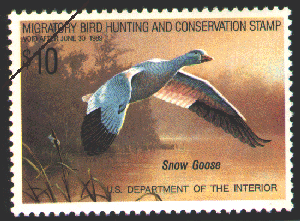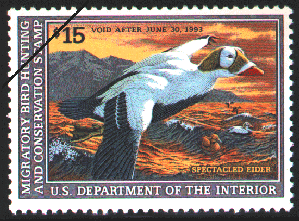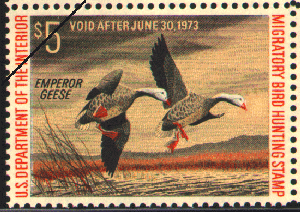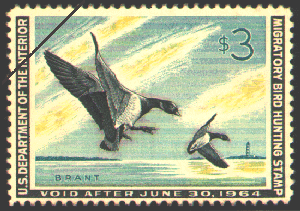![]()
 Hudson Bay Population and Community
Ecology - As the numbers of lesser snow geese in the breeding
colonies along Hudson and James Bays have increased, these
herbivores have outstripped their resources and begun a trophic
cascade - a pattern of run-away consumption that impacts all
levels and members of the simple food chain typical of arctic
coastal ecosystems. While degradation of the habitat results in a
reduction in local reproductive success for the snow geese, they
escape the control of density-dependent population regulation by
dispersing to adjacent, less degraded areas. In doing this, their
geographically expanded population continues to increase and the
trophic cascade spreads along the coast as an ever-expanding wave
of habitat destruction. We have assembled a research team that is
studying the population and community ecology of the plants and
animals sharing this coastal tundra ecosystem. My primary
contributions to the effort center on long-term monitoring of the
snow geese and common eiders as well as studying their foraging,
nesting and brood rearing behavior. I am also monitoring the
success and dynamics of the region's avian community, especially
in relation to potential impact by the snow goose induced trophic
cascade. A detailed account of all aspects of our collaborative
work can be accessed at the Hudson Bay Project . The site is under construction.
Hudson Bay Population and Community
Ecology - As the numbers of lesser snow geese in the breeding
colonies along Hudson and James Bays have increased, these
herbivores have outstripped their resources and begun a trophic
cascade - a pattern of run-away consumption that impacts all
levels and members of the simple food chain typical of arctic
coastal ecosystems. While degradation of the habitat results in a
reduction in local reproductive success for the snow geese, they
escape the control of density-dependent population regulation by
dispersing to adjacent, less degraded areas. In doing this, their
geographically expanded population continues to increase and the
trophic cascade spreads along the coast as an ever-expanding wave
of habitat destruction. We have assembled a research team that is
studying the population and community ecology of the plants and
animals sharing this coastal tundra ecosystem. My primary
contributions to the effort center on long-term monitoring of the
snow geese and common eiders as well as studying their foraging,
nesting and brood rearing behavior. I am also monitoring the
success and dynamics of the region's avian community, especially
in relation to potential impact by the snow goose induced trophic
cascade. A detailed account of all aspects of our collaborative
work can be accessed at the Hudson Bay Project . The site is under construction.
 Population Dynamics - Using both
individual based models and matrix projection models, we are
examining the population dynamics of several species of migratory
waterfowl including snow geese, emperor geese, northern pintails
and spectacled eiders. One goal of the work is to develop
accurate models of both short- and long-term population growth of
these species for management purposes. Another goal centers on
understanding the relative impacts of the underlying demographic
parameters (e.g. breeding propensity, nesting success, adult
survival) on population dynamics - especially under conditions of
density-dependence, non-linear interaction among demographic
parameters and environmental stochasticity. We have begun
expanding both data collection and modeling efforts to structured
assemblages of the species with dispersal connecting the
subpopulations. Source-sink systems are of particular interest.
Much of this work is in collaboration with Barry Grand and Paul
Flint of The Alaska Science Center, Biological Resources Division, US
Geological Survey. Progress can be found at http://www.absc.usgs.gov/research/speimod/
Population Dynamics - Using both
individual based models and matrix projection models, we are
examining the population dynamics of several species of migratory
waterfowl including snow geese, emperor geese, northern pintails
and spectacled eiders. One goal of the work is to develop
accurate models of both short- and long-term population growth of
these species for management purposes. Another goal centers on
understanding the relative impacts of the underlying demographic
parameters (e.g. breeding propensity, nesting success, adult
survival) on population dynamics - especially under conditions of
density-dependence, non-linear interaction among demographic
parameters and environmental stochasticity. We have begun
expanding both data collection and modeling efforts to structured
assemblages of the species with dispersal connecting the
subpopulations. Source-sink systems are of particular interest.
Much of this work is in collaboration with Barry Grand and Paul
Flint of The Alaska Science Center, Biological Resources Division, US
Geological Survey. Progress can be found at http://www.absc.usgs.gov/research/speimod/
 Lifetime Reproductive Success - The
mean and variance of lifetime reproductive success (ELRS and
VLRS, respectively) are key parameters influencing the
evolutionary dynamics of species. They also play a critical role
in the shorter-term dynamics of species being managed for
conservation purposes. While the meaning of these parameters is
conceptually obvious, their estimation from real populations is
fraught with difficulties. For birds, these range from our
inability to precisely monitor survival of individually marked
hatchlings to confusion between mortality and permanent
emigration to issues of determining true paternity and maternity
in mating systems that are seldom purely definable. Using both
mathematical approaches and individual based modeling, we have
been developing procedures to estimate ELRS and VLRS with less
than complete data and have been testing them with data from
several long-term studies including our work with lesser snow
geese and work on emperor geese that has been carried out by Joel
Schmutz and Margaret Petersen of The Alaska Science Center, Biological Resources Division, US
Geological Survey. We are also developing procedures with which
these incomplete data estimators of ELRS and VLRS can be used to
generate estimates of other important parameters such as
effective population size (Ne). In all cases, we attempt to
provide tests to ascertain whether field data conform to the
assumptions of our procedures.
Lifetime Reproductive Success - The
mean and variance of lifetime reproductive success (ELRS and
VLRS, respectively) are key parameters influencing the
evolutionary dynamics of species. They also play a critical role
in the shorter-term dynamics of species being managed for
conservation purposes. While the meaning of these parameters is
conceptually obvious, their estimation from real populations is
fraught with difficulties. For birds, these range from our
inability to precisely monitor survival of individually marked
hatchlings to confusion between mortality and permanent
emigration to issues of determining true paternity and maternity
in mating systems that are seldom purely definable. Using both
mathematical approaches and individual based modeling, we have
been developing procedures to estimate ELRS and VLRS with less
than complete data and have been testing them with data from
several long-term studies including our work with lesser snow
geese and work on emperor geese that has been carried out by Joel
Schmutz and Margaret Petersen of The Alaska Science Center, Biological Resources Division, US
Geological Survey. We are also developing procedures with which
these incomplete data estimators of ELRS and VLRS can be used to
generate estimates of other important parameters such as
effective population size (Ne). In all cases, we attempt to
provide tests to ascertain whether field data conform to the
assumptions of our procedures.
 Genetic Structure and Gene Flow - Few
species are distributed continuously. Rather, they exist as
disjunct populations connected by gene flow. Inferences regarding
the evolutionary dynamics of such assemblages and decisions
regarding their conservation and management require estimates of
genetic structure and gene flow. Many of the current estimation
procedures using direct examination of genetic variation in field
situations appeal to often untested or untestable assumptions
regarding selection, equilibrium and the pattern and stability of
patterns of genetic exchange among the populations. Our work in
this area centers on 3 main areas: 1) development of models that
use demographic data to predict the genetic structure that is (or
can be) then tested for conformity; 2) examination of the
robustness of measures of genetic structure and gene flow to
departures from underlying assumptions; 3) development of
topological approaches to the estimation of genetic structure and
gene flow using gene trees and coalescence theory. Our initial
applications involve the Pacific black brant in collaboration
with Mark Lindberg.
Genetic Structure and Gene Flow - Few
species are distributed continuously. Rather, they exist as
disjunct populations connected by gene flow. Inferences regarding
the evolutionary dynamics of such assemblages and decisions
regarding their conservation and management require estimates of
genetic structure and gene flow. Many of the current estimation
procedures using direct examination of genetic variation in field
situations appeal to often untested or untestable assumptions
regarding selection, equilibrium and the pattern and stability of
patterns of genetic exchange among the populations. Our work in
this area centers on 3 main areas: 1) development of models that
use demographic data to predict the genetic structure that is (or
can be) then tested for conformity; 2) examination of the
robustness of measures of genetic structure and gene flow to
departures from underlying assumptions; 3) development of
topological approaches to the estimation of genetic structure and
gene flow using gene trees and coalescence theory. Our initial
applications involve the Pacific black brant in collaboration
with Mark Lindberg.
These images can be accessed on the US Fish and Wildlife Service Federal Duck Stamp Homepage
![]()
revised - October 06, 2000